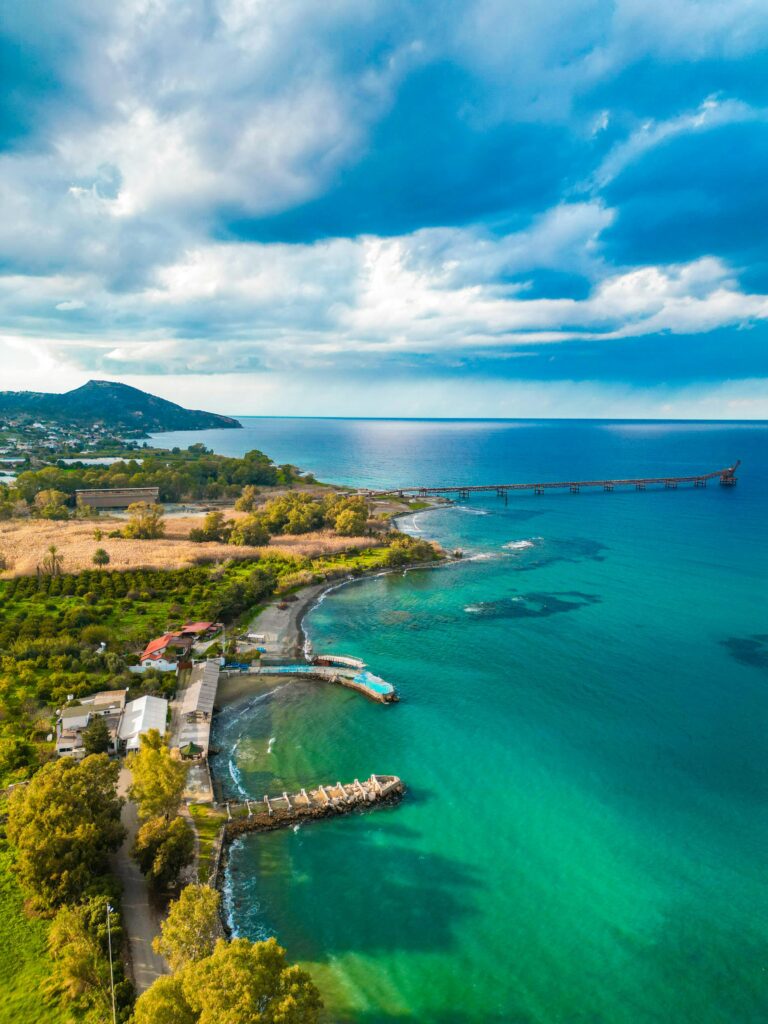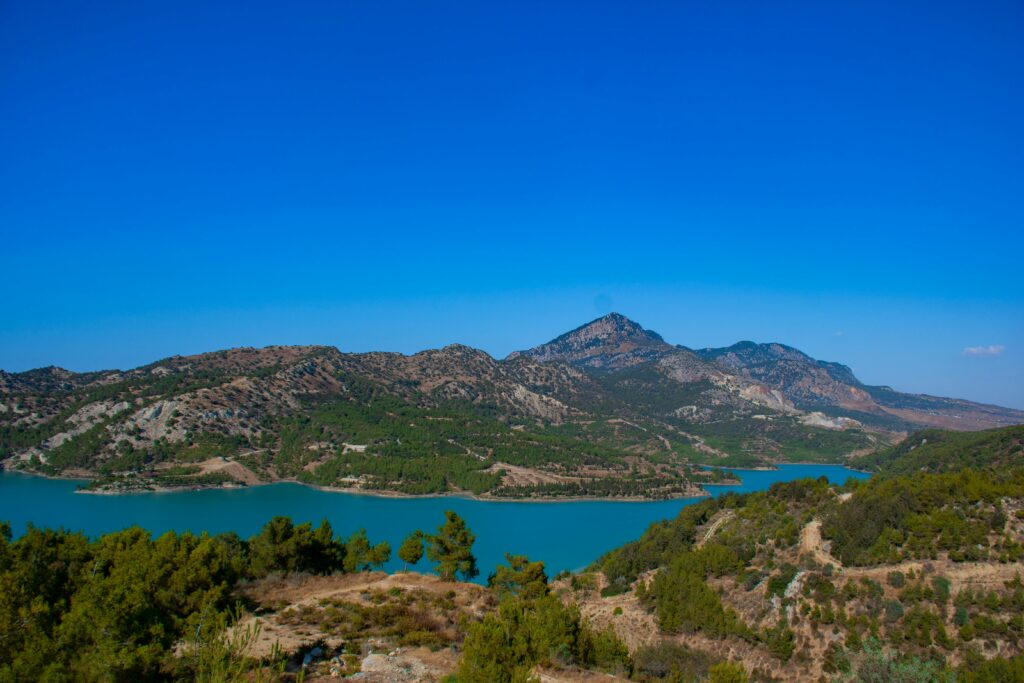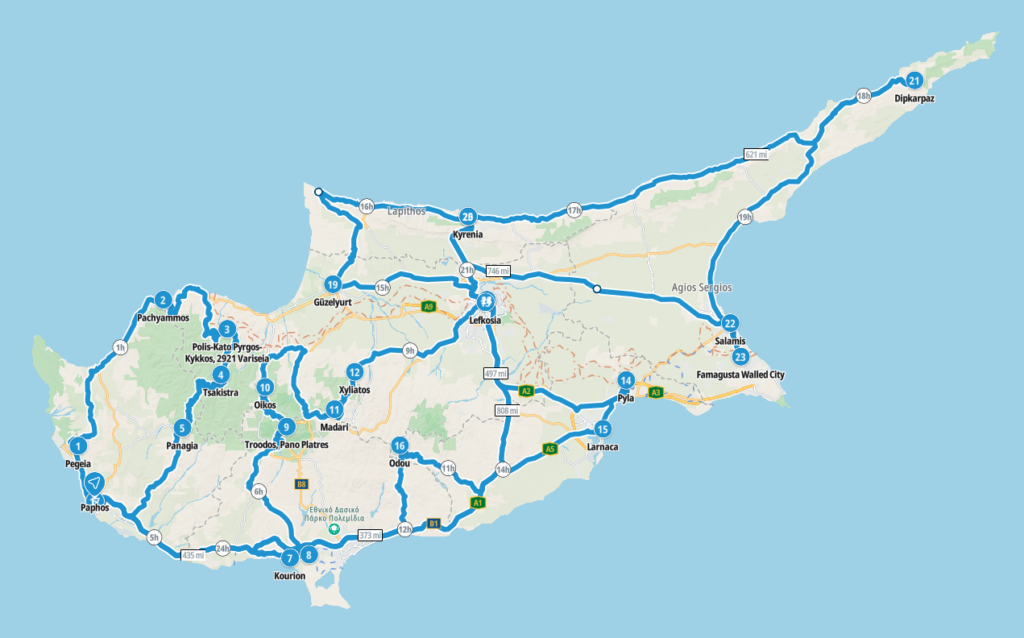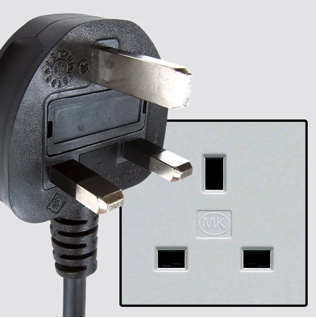Cyprus / Κυπριακή Δημοκρατία / Kıbrıs Cumhuriyeti – Let’s explore here
What’s it like in Cyprus?
Cyprus is a transcontinental country – it is located both in Europe and in Asia. Because of this, the information on the country is located both in our European and in our Asian travel destination sections. Don’t worry though, all the information for this amazing country is captured on this page.
The island of Cyprus sits in the east of the Mediterranean Sea, about 50 miles (80 km) south of Turkey, and about 65 miles (105 km) west of Syria and Lebanon. It is a spectacular island, particularly along the coasts, and in the mountains and forests. We were surprised just how much there is to see and do, as it’s not a large island, being about 150 miles (240 km) long by 60 miles (95 km) wide. The highest point is Mount Olympus, just west of the centre of the country, at 6,404 ft (1,952 m).
The southern two thirds of the island is occupied by the Republic of Cyprus. Whereas the northern third is occupied by the Turkish Republic of Northern Cyprus. As the latter isn’t recognised internationally (except by Turkey), the United Nations provides a controlled Green Line as a buffer zone between the two.
The population of Cyprus is almost 1 million people (2021), about one in four of whom live in the metropolitan area of the capital, Nicosia.


A bit about the history of Cyprus
Cyprus has a long and complex history, shaped by its strategic location in the eastern Mediterranean and its diverse cultural influences.
Ancient and Medieval History
Cyprus has been inhabited since prehistoric times. In antiquity, it was home to various civilisations, including the Mycenaeans and Phoenicians, and was later part of the ancient Greek world. Cyprus was controlled by successive empires, including the Egyptians, Persians, and Alexander the Great’s empire. After the fall of Alexander’s empire, Cyprus became part of the Ptolemaic Kingdom of Egypt.
Roman and Byzantine Periods
Cyprus became part of the Roman Empire in 58 BCE and later the Byzantine Empire. During this time, the island became predominantly Christian. The island’s strategic position made it a key part of the Byzantine Empire’s defense system.
Medieval Period and Venetian Rule
In the medieval period, Cyprus was ruled by a series of different powers, including the Crusaders, who controlled the island from the 12th century. In the 15th century, it came under Venetian control, which lasted until the Ottoman Empire took over in 1571.
Ottoman Rule
Cyprus was under Ottoman rule from 1571 to 1878. During this time, many Greek Cypriots converted to Islam, and the island was administered as part of the Ottoman Empire. Cyprus remained under Ottoman control until the late 19th century.
British Rule
In 1878, Cyprus was leased to the British Empire, though it remained formally part of the Ottoman Empire until 1914, when Britain annexed it during World War I. Cyprus became a British colony in 1925, and tensions grew between the Greek Cypriots, who sought union with Greece (Enosis), and the Turkish Cypriots, who opposed it.
Independence and Intercommunal Violence
Cyprus gained independence from Britain in 1960, with a power-sharing arrangement between Greek and Turkish Cypriots. However, ethnic tensions led to intercommunal violence in the 1960s. In 1974, following a Greek-backed coup in Cyprus, Turkey invaded the northern part of the island, leading to the division of the island along a “Green Line” and the establishment of the Turkish Republic of Northern Cyprus (recognized only by Turkey).
Recent History
Cyprus remains divided to this day, with the southern part of the island controlled by the internationally recognized Republic of Cyprus and the northern part under Turkish Cypriot control. Various attempts at reunification have been made, including the Annan Plan in 2004, but they have not succeeded. Cyprus joined the European Union in 2004, but the division remains a significant issue. Today, Cyprus continues to be a focal point of international diplomacy, with efforts toward reunification ongoing, while also being a popular tourist destination and a member of the EU.

Cyprus road trip
Map of our Cypriot road trip

This is a map of our planned road trip around Cyprus.
The route takes us from Paphos – Pegeia – Pachyammos – Tsakistra – Panagia – Paphos – Kourion – Kolossi – Troodos – Oikos – Madari – Xyliatos – Lefkosia – Pyla – Larnaca – Odou – Paphos – Nicosia – Güzelyurt – Kyrenia – Dipkarpaz – Salamis – Famagusta – Nicosia – Kyrenia – Paphos
Our favourite places in Cyprus
These are some of the best places that we explored on our road trip through Cyprus. We’ve put them in alphabetical order.
Nicosia – Lefkosía / Lefkoşa
Last time we were in Cyprus, we travelled by ferry from Haifa, Israel to Cyprus. So when we arrived in Limassol, it was our first point of entry back into Europe. We visited Nicosia and found accommodation really easy to find, and we found Cyprus to be a really interesting place with lots to see and do. There’s loads of historic architecture, particularly Roman, Ottoman and relating to the Crusades and the Knights Templar. There’s also loads of restaurants, bars and cafés, and the people are really friendly and helpful.
Don’t fall for the trap of asking for a large beer though – unless you wish to drink from a double Stein!

What’s it like to drive in Cyprus?
They drive on the left hand side of the road across the whole island of Cyprus. We found driving throughout the country to be a fairly laid-back affair. Nobody drives quickly, and there’s not a lot of traffic between most town and cities compared with the UK. We took a SatNav as we found that road signage can be pretty hit-n-miss in rural areas, and often signs are placed only where you can see them at the last moment.
Do you require an international driving permit in Cyprus?
We’ve created a dedicated page to driving abroad, which answers this question, and more, which you might find helpful.
Can you use your UK driving license when driving through Cyprus?
We’ve created a dedicated page to driving abroad, which answers this question, and more, which you might find helpful.
Do I need a carnet de passages to drive in Cyprus?
We’ve created a dedicated page to driving abroad, which answers this question, and more, which you might find helpful.
What are the speed limits in Cyprus?
As with driving in the UK, they drive on the left hand side of the road across the whole island of Cyprus.
The speed limits for cars in Cyprus are:
- 20 mph (30 km/h) for urban driving
- 30 mph (50 km/h) outside of built up areas
- 50 mph (80 km/h) on dual carriageways
- 60 mph (100 km/h) on motorways
Crossing the border with a car in Cyprus
If you enter the island of Cyprus via Northern Cyprus, you will be deemed to have entered the country illegally should you attempt to cross into the Republic of Cyprus!
If you drive your own car, check your travel insurance. As, if you’re from the UK or the EU, you most probably will be covered for South Cyprus as a minimum, you may even be covered for Northern Cyprus also. If you’ve entered the island via the Republic of Cyprus, you can travel across the border in both directions, although you may have to pay third party insurance for travel in Northern Cyprus.
If you hire a car in Northern Cyprus you are not allowed to take it across the border into the Republic of Cyprus. However if you hire a car in the Republic of Cypru,s you can take it across the border into Northern Cyprus, and back again. However only some hire car companies will allow you to do so, and you will have to pay additional third party insurance at the border.
What currency do they use in Cyprus?
In the Republic of Cyprus they use the Euro. In Northern Cyprus they use Turkish Lira, however Euro and pound sterling are also accepted. The use of credit / debit cards is now widespread. Travellers cheques are accepted. There are lots of ATMs.
You should make yourself aware of the amount that your bank charges you for using credit and debit cards abroad. Often credit cards are cheaper for purchasing items directly, and for withdrawing cash from ATMs.
What language do they speak in Cyprus?
On the Greek side they speak Greek and on the Turkish side they speak Turkish. We found that English is widely spoken throughout the island.
What time zone is Cyprus in?
Remember, when you’re planning your next trip to take a look at what time zone it’s in.
Do I need a visa to visit Cyprus?
We’ve created a dedicated, more comprehensive page on visas, which you should find helpful. Check it out!
Is wild camping legal in Cyprus?
No, wild camping is Illegal in Cyprus.
What plug / socket type do they use in Cyprus?

In Cyprus they use plug / socket type G.
Health issues in Cyprus
Is it safe to drink water in Cyprus?
Yes, it is safe to drink tap water in Cyprus, although in our experience much of it has an unusual taste. Bottled water is also readily available across the country.
What vaccinations are required for Cyprus?
This NHS website is kept up to date with all relevant information on vaccinations in Cyprus.
Phones in Cyprus
What is the country calling code for Cyprus?
The country calling code for the Republic of Cyprus is +357
The country calling code for the Turkish Republic of Northern Cyprus is +90 392
What are the emergency phone numbers in Cyprus?
- The emergency number for police in Cyprus is: 112 / 199
- In Cyprus, the emergency number for ambulance is: 112 / 199
- The emergency number for fire in Cyprus is: 112 / 199
If you’ve got some useful info that you’d like to share, let us know!
Don’t forget to check out all the other pictures!
